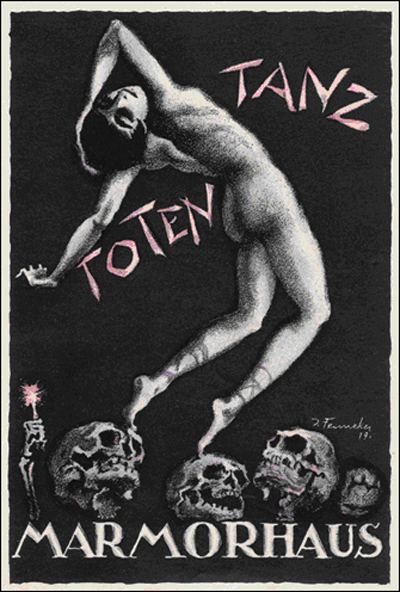The Frantic Expressionist Art of Josef Fenneker

Nerven, Marmorhaus
There is a weirdly compelling sort of attraction to the exaggerated melodrama present in Josef Fenneker’s work. Inky backgrounds of blackest shadows and murky, moody gloom provide stark contrast to bloodless facial expressions, vivid with violent emotion – whether delirious passion, or murderous lunacy – and it is not difficult to imagine oneself mesmerized, whipped into a maelstrom of sympathetic mania when confronted with such imagery.

Toten Tanz, Marmorhaus
Fenneker, a German artist in 1920s Berlin, “became the eye of the cultural and political hurricane that was Weimar Germany”. A painter, graphic designer, and stage designer, he worked in a “mixed style, strongly tinged with expressionist characteristics”, and there is the foreboding of gathering storms and imminent, though decadent, doom in almost all his work.
Born in 1895, the son of a grocer, little of Josef Fenneker’s early life in Bocholt is known. Perhaps inspired by his uncle Anton Marx, a church painter and architect, Fenneker studied at the Arts and Crafts schools in Munster, Dusseldorf and Munich, and became one of Emil Orlik’s master-class students at the school of the Berlin Arts and Crafts Museum.
First employed by Berlin theaters – most notably the Marmorhaus, the “paramount movie palace of Germany” – Fenneker designed numerous film posters, between 1919 and 1924. A “ combination of Radio City Music Hall and Graumans Chinese Theater”, any film premiering there gained “instant prestige”. Thus, Fenneker was not just another movie poster designer, but THE movie posterist of his day, in whose hands the “art of the film poster arguably reached its zenith,” and in the postwar years he became “one of the most sought after designers of film posters. “ Fenneker went on to create stage designs for theater and illustrations for such magazines as Simplicissimus and Jugend.
Josef Fenneker died in Frankfurt in January1956 of heart failure. In the obituaries of the regional and national press, he was noted as one of the most important and most original German set designers of the 1920s and 1930s. More than 300 works have been preserved from his vast oeuvre by the Deutsche Kinemathek in Berlin, several more of which can be seen below the cut.



